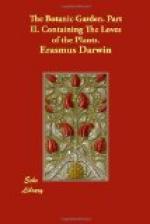185 In sulphurous eddies round the weird dame
Plays
the light gas, or kindles into flame.
If
rests the traveller his weary head,
Grim
MANCINELLA haunts the mossy bed,
Brews
her black hebenon, and, stealing near,
190 Pours the curst venom in his tortured ear.—
Wide
o’er the mad’ning throng URTICA flings
Her
barbed shafts, and darts her poison’d stings.
[Mancinella, I. 188. Hyppomane. With the milky juice of this tree the Indians poison their arrows; the dew-drops, which fall from it, are so caustic as to blister the skin, and produce dangerous ulcers; whence many have found their death by sleeping under its shade. Variety of noxious plants abound in all countries; in our own the deadly nightshade, henbane, hounds-tongue, and many others, are seen in almost every high road untouched by animals. Some have asked, what is the use of such abundance of poisons? The nauseous or pungent juices of some vegetables, like the thorns of others, are given them for their defence from the depredations of animals; hence the thorny plants are in general wholesome and agreeable food to graminivorous animals. See note on Ilex. The flowers or petals of plants are perhaps in general more acrid than their leaves; hence they are much seldomer eaten by insects. This seems to have been the use of the essential oil in the vegetable economy, as observed above in the notes on Dictamnus and on Ilex. The fragrance of plants is thus a part of their defence. These pungent or nauseous juices of vegetables have supplied the science of medicine with its principal materials, such as purge, vomit, intoxicate, &c.]




